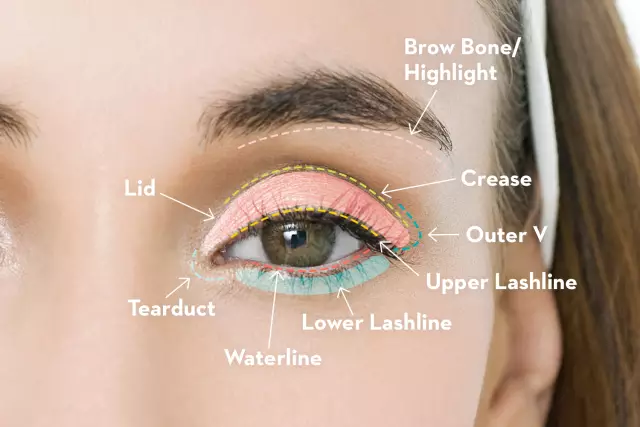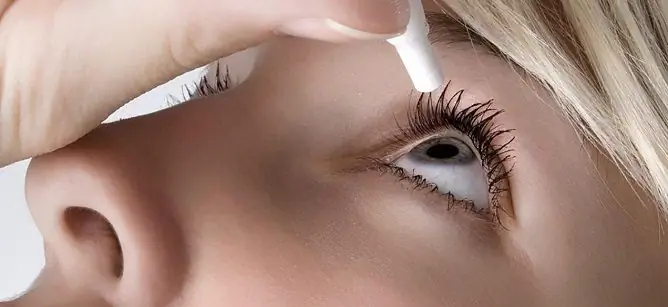- Author Rachel Wainwright [email protected].
- Public 2023-12-15 07:39.
- Last modified 2025-11-02 20:14.
Dorzopt
Dorzopt: instructions for use and reviews
- 1. Release form and composition
- 2. Pharmacological properties
- 3. Indications for use
- 4. Contraindications
- 5. Method of application and dosage
- 6. Side effects
- 7. Overdose
- 8. Special instructions
- 9. Application during pregnancy and lactation
- 10. Use in childhood
- 11. In case of impaired renal function
- 12. For violations of liver function
- 13. Use in the elderly
- 14. Drug interactions
- 15. Analogs
- 16. Terms and conditions of storage
- 17. Terms of dispensing from pharmacies
- 18. Reviews
- 19. Price in pharmacies
Latin name: Dorzopt
ATX code: S01EC03
Active ingredient: Dorzolamide (Dorzolamide)
Manufacturer: CO Rompharm Company SRL (Romania)
Description and photo update: 18.10.2018
Prices in pharmacies: from 303 rubles.
Buy

Dorzopt is an antiglaucoma drug.
Release form and composition
Dosage form - eye drops 2%: colorless, transparent (in polymer dropper bottles or bottles with a dropper stopper of 5 ml, in a cardboard box 1 bottle / dropper bottle).
Composition of 1 ml drops:
- active substance: dorzolamide (in the form of hydrochloride) - 20 mg;
- auxiliary components: sodium hydroxide - 2.4 mg; hyethylose - 1 mg; mannitol - 20 mg; benzalkonium chloride - 0.1 mg; citric acid monohydrate - 4 mg; purified water - up to 1 ml.
Pharmacological properties
Pharmacodynamics
Dorzolamide is one of the antiglaucoma drugs. Carbonic anhydrase inhibitor; reduces the secretion of intraocular fluid by slowing down the formation of bicarbonate, followed by weakening the transfer of water and Na +. Miosis, spasm of accommodation and hemeralopia does not cause.
Pharmacokinetics
Dorzolamide penetrates into the eye, mainly through the cornea (through the sclera or limbus - to a lesser extent). Has low systemic absorption. It quickly penetrates into red blood cells after entering the bloodstream.
The connection with plasma proteins is 33%.
It is transformed into an N-desethylated metabolite, which exhibits less activity against carbonic anhydrase II, but retains the ability to block carbonic anhydrase I. With prolonged use, it accumulates in erythrocytes.
It is excreted in the form of metabolites and unchanged by the kidneys. After the cancellation of therapy, the slow phase of elimination is replaced by the fast one, which is due to the gradual release of the substance from the erythrocytes. The half-life is approximately 4 months.
Indications for use
- open-angle glaucoma, including secondary;
- ophthalmic hypertension;
- pseudoexfoliative glaucoma.
Contraindications
Absolute:
- hyperchloremic acidosis;
- chronic renal failure (with creatinine clearance less than 30 ml / min);
- combined use with oral carbonic anhydrase inhibitors;
- age up to 18 years;
- pregnancy and lactation;
- individual intolerance to the components of the drug.
Relative (diseases / conditions in which the appointment of Dorzopt requires caution and medical supervision):
- corneal disease;
- liver failure;
- diabetes;
- conditions after antiglaucomatous operations (associated with the risk of retinal detachment, hypotension of the eye).
Instructions for use of Dorzopt: method and dosage
According to the instructions, Dorzopt should be instilled 1 drop into the conjunctival sac of the affected eye.
Multiplicity of application:
- monotherapy - 3 times a day;
- combination with local beta-blockers - 2 times a day.
If therapy involves the use of other topical ophthalmic drugs, it is necessary to observe an interval of 10 minutes between their administration.
Side effects
- systemic reactions: asthenia, bitterness in the mouth, headache, nausea, nephrourolithiasis, Lyell and Stevens-Johnson syndromes, aplastic anemia, agranulocytosis, skin rashes;
- local reactions: photophobia, burning sensation, paresthesias, itching in the eyes, conjunctivitis, blurred vision, lacrimation, eyelid edema / irritation, blepharitis, superficial punctate keratitis; rarely - hypotension of the eye, iridocyclitis, an increase in the thickness of the cornea, retinal detachment after antiglaucomatous operations, allergic reactions.
Overdose
The main symptoms: acidosis, disorders of water and electrolyte metabolism, disorders of the central nervous system.
Treatment is symptomatic. Monitoring of blood pH and electrolytes (especially potassium) is required.
special instructions
Benzalkonium chloride, which is part of Dorzopt eye drops as a preservative, is adsorbed by soft contact lenses, which can cause eye irritation and toxic effects. In this regard, contact lenses must be removed before using the drug. They can be reinstalled 15 minutes after instillation.
During the period of therapy, the serum content of potassium, electrolytes in the blood and its pH should be monitored.
Influence on the ability to drive vehicles and complex mechanisms
During the course, when driving vehicles, patients should be careful.
Application during pregnancy and lactation
The period of pregnancy and lactation is a contraindication to the use of the drug.
Pediatric use
The drug is contraindicated in patients under 18 years of age.
With impaired renal function
Chronic renal failure (with creatinine clearance less than 30 ml / min) is a contraindication to the use of Dorzopt eye drops.
For violations of liver function
In patients with hepatic impairment, the drug should be administered with caution.
Use in the elderly
In elderly patients, an increase in sensitivity to dorzolamide may be observed, so they are recommended to use the drug in reduced doses.
Drug interactions
With the simultaneous use of certain drugs / substances, the following effects may develop:
- drugs with antiglaucoma action (pilocarpine, beta-blockers, dipivefrin, carbachol): increased action of dorzolamide;
- acetazolamide: an increase in the likelihood of systemic adverse reactions;
- acetylsalicylic acid (in large doses): increased toxicity.
Analogs
The analogue of Dorzopt is Trusopt.
Terms and conditions of storage
Store in a place protected from light and moisture at temperatures up to 25 ° C. Keep out of the reach of children.
Shelf life is 2 years. After opening the package, the drops can be used for 4 weeks.
Terms of dispensing from pharmacies
Dispensed by prescription.
Reviews about Dorzopt
There are few reviews about Dorzopt, which testify to its effectiveness and availability.
Some patients note the development of systemic and local adverse reactions.
Price for Dorzopt in pharmacies
The price for Dorzopt (3 bottles of 5 ml each) varies from 1190 to 1460 rubles.
Dorzopt: prices in online pharmacies
|
Drug name Price Pharmacy |
|
Dorzopt 2% eye drops 5 ml 1 pc. 303 RUB Buy |
|
Dorzopt Plus 20 mg / ml + 5 mg / ml eye drops 5 ml 1 pc. 717 RUB Buy |
|
Dorzopt Plus eye drops 2% 5ml 820 RUB Buy |
|
Dorzopt 2% eye drops 5 ml 3 pcs. 1109 RUB Buy |

Maria Kulkes Medical journalist About the author
Education: First Moscow State Medical University named after I. M. Sechenov, specialty "General Medicine".
Information about the drug is generalized, provided for informational purposes only and does not replace the official instructions. Self-medication is hazardous to health!






